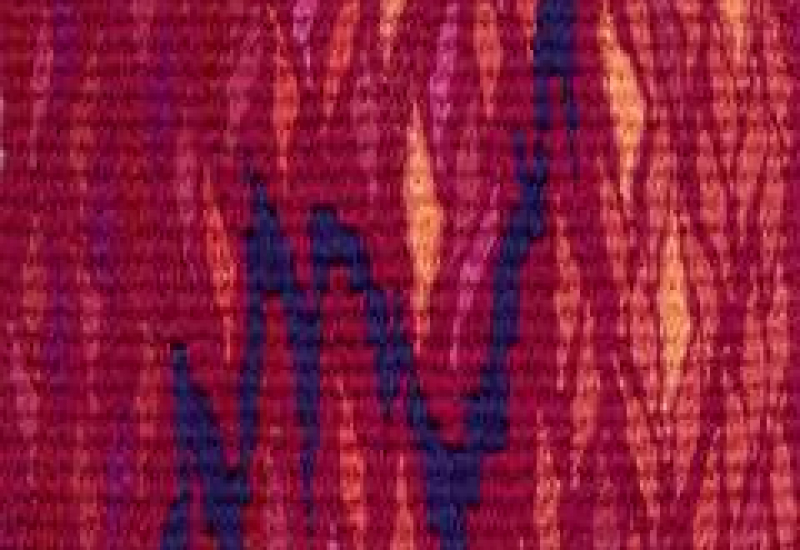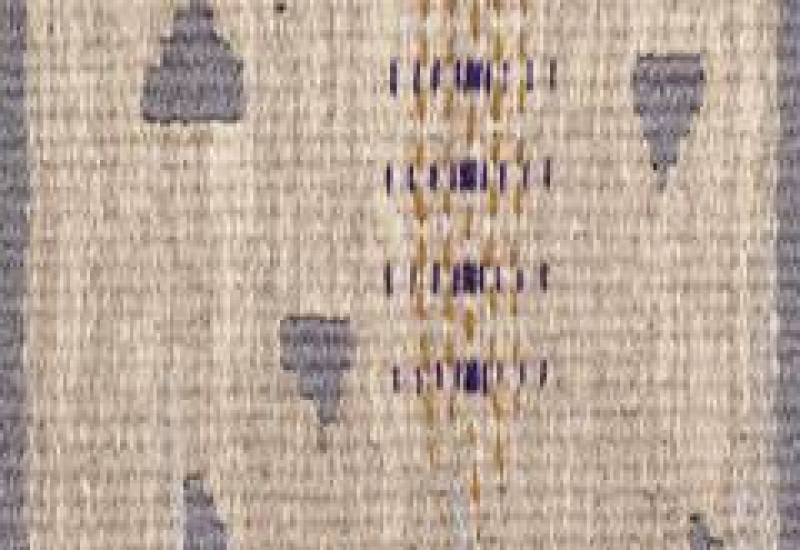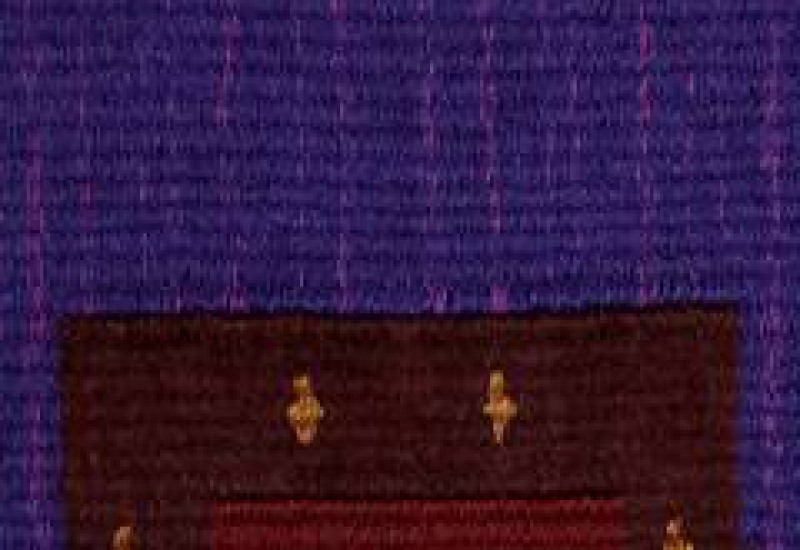

Berit Engen Tapestries
A visual story of the Israelites receiving and accepting the covenant after their exodus from Egypt and crossing the Red Sea.

Berit Engen’s series of tapestries, “Mount Sinai on Route 43 – From the Shore of the Sea to the Mishkan in Our Hearts,” tells the story of the Israelites receiving and accepting the covenant after their exodus from Egypt and crossing the Red Sea, focusing on the theme of Revelation. Installed in Temple Har Zion’s lobby, this set of 10 tapestries was designed to be viewed moving from the east (street) side of the lobby to the west side.
These exquisite works reveal the deep artistry and spirituality of their creator. Engan shared, “I use a deep, purplish blue to symbolize t’chelet, the ‘Jewish’ blue mentioned in the Torah, and which we were commanded to use in the tzitzit in the four corners of our prayer shawls. I have woven it into all 10 tapestries, symbolizing a specific object or concept in each piece.”
The tapestries were presented to Temple Har Zion by the artist on December 4, 2021
“Judaism connects the enormous time span between our past and present by demanding that we continually redefine who we are. Har Zion uniquely encourages the process through the temple’s commitment to visual arts: it recognizes that our experience of gazing at colors and shapes depicting our story and concepts has the ability to transform knowledge of our heritage into tangible moments of awe. I am deeply grateful to have been invited into Har Zion’s admirable community of artists. I hope that the ten tapestries will invite the ongoing process of becoming who we aspire to be.”
– Berit Engen, Oak Park, IL
Click here to watch her presentation of the tapestries.
The Tapestry Story
Celebrating by the Sea at the Edge of Our Wandering
In the first tapestry, over the dancing waving forms melding together celebrating freedom, the sun illuminates – in a column of clear light – Mount Sinai in the distance where they are to meet God. We understand this element of the story as a reminder. Even in triumph, we are ever, as human beings, walking towards our next trial in our growth, to a deeper self-understanding and meeting with holiness.
“We joined Miriam and the women as they lifted their timbrels and danced after the miraculous crossing of the Sea of Reeds. But somewhere in the distance there was a mountain. God’s intention was not simply to free us from slavery and save us from the Pharaoh’s army, but to bring us to sign the covenant at Sinai.”
Miracles Received While the Wilderness Surrounded Us
This second tapestry depicts the beginning of the Children of Israel’s long journey to Sinai (and then beyond to the Promised Land). Neon-like manna falls from the sky. We see sky, manna, and the ground fusing – into each other in the neon orange. Where exactly did the journey of the Israelites take place? Were they on heaven or on earth? Food was falling from the sky. In this subliminal space, the Jewish people took their first steps and got to know the One who had freed them from Egypt.
“Shlepping through the wilderness was no easy trek. We were tired, thirsty and hungry. God performed miracles, as God had done for us in Egypt. Water appeared, and food: manna at dawn and quail in the twilight.”
The Attack to Annihilate Us We Fought and Won
There were challenges on the way to Sinai. Berit depicts the battle with Amalek as sharp blades cutting through wavy light blues. Amalek struck Israel’s weakest as they fled Egypt. We see the waves engulf a small, lonely rock, a storm amidst their travels. However, to me at least, the waves do not appear overly threatening. They are a brilliant blue, the color of tekhelet and of the Divine. They come to teach us, even the challenges and the ‘evil’ are there to push us along in our growth.
“The Amalekites attacked us with the intent to wipe us out. We were on our own without God’s intervening miracles to help us. In dire self-defense we killed, but we defeated the enemy – a true turning point.”
Standing Before the Trembling Rock on the Day of Calling
In the 4th tapestry, the Children of Israel stand before the mountain –Mount Sinai. They appear as tiny figures in red with the mountain looming above. The perspective and the sensation of looking up in this image is striking. Ultimately, Judaism does not believe that God is up (or down), and yet our human vantage point and inner compass always steers us upwards.
“The arrival at Mount Sinai reached its zenith the day the big rock trembled, and we felt small at the foot of the mountain as we watched with awe and fear the lightning tear the heavens and we could not escape the cacophonic blasts of the shofarot. We huddled together, overwhelmed by the reality of God’s presence.”
In God’s Hands: “Na’aseh…
The 5th and 6th tapestries are powerful depictions of the moment of the revelation of the Ten Commandments themselves. In our synagogue, the two tapestries appear on each side of the doors opening into our sanctuary. In Berit’s vision, revelation has no distinct form or shape. All we see is the shape of the mountain ascending up on one tapestry and then descending down the other.
“We showed our commitment to the Torah when at Sinai we proclaimed ‘na’aseh v’nishma!’ – ‘we will do and we will listen!’ Crimson symbolizes the Israelites, as in tapestries one, four, and ten. But here, and in tapestry six, although we are shapeless individuals, we are community, and it is as community that we can change the world. Our commitment to the Law is woven as a mythical Mount Sinai in t’khelet.”
. . . v’Nishma!”
In the tapestries, surrounding the mountain is a reddish fiery light, symbolizing the people and their experience. This was not the peace of the “still small voice” of the prophet Elijah. This was a burning engraving into the hearts and souls of the Jewish people forever – until we fulfill the purpose, we were handed that day.
“God gave us Shabbat, the Day of Rest to be observed by every generation in any place we might reside. Described by Abraham Heschel as a “palace in time,” it is woven in a floating setting, as if a definite, concrete place does not exist. Since God intended Shabbat to be a holy ritual, we beautify the Day of Rest with the same intent, kavannah, as the artisans B’zalel and Oholiab beautified the portable, sanctuary, the mishkan.”
As If Adorned by B’tzalel: Shabbat Ot B’rit Olam v’Nishma!”
In the 7th tapestry, from the fire of revelation, we are taken into the most calm, harmonious and beautified of all of the weavings. Am Yisrael are handed Shabbat -the cornerstone of their covenant with God, woven in t’khelet. T’khelet in the Talmud is said to reflect the radiance of the sea below, of the sky above, and of the Throne of Glory in the heavens. Shabbat is a day to revive in spirit, and taste of ‘The World to Come’. Throughout are beautiful branches bearing fruit, symbolizing the spiritual blessings Shabbat carries into our lives.
“God gave us Shabbat, the Day of Rest to be observed by every generation in any place we might reside. Described by Abraham Heschel as a “palace in time,” it is woven in a floating setting, as if a definite, concrete place does not exist. Since God intended Shabbat to be a holy ritual, we beautify the Day of Rest with the same intent, kavannah, as the artisans B’zalel and Oholiab beautified the portable sanctuary, the mishkan.”
Our Broken Commitment and God’s Mercy
According to our sages, after the revelation, the Jews did not need any more instruction. They naturally dwelt in the consciousness of Oneness. But they could only hold that loftiness for a short while. The 8th tapestry shows the repercussion of their epic failure. Above the golden calf are depicted 13 pulsating spheres – vibrating with Divine force. As the people of compassion, we still chant the attributes in our holiday liturgy.
“In his anger over our creating a false god, Moses broke the first set of tablets, woven here as grey shards. He destroyed the golden calf, and it disappeared as dust in a stream. At this historic low point God could have given up on us and searched for another covenant-willing tribe, and we could have lost it all. Instead, God declared His Thirteen Attributes of Mercy, here woven in t’khelet. On both sides of the tapestry are grey-colored hints of the second set of tablets that Moses brought down from the mountain top. I chose to weave, in a rather quiet-looking tapestry, these four consecutive events as if they took place at once, suggesting a powerful connection between these four emotional and historically consequential episodes.”
God’s Sacred Dwelling Place That We Built
In the 9th tapestry, Berit weaves God’s instruction to the people to build a tabernacle – “so that I may dwell among You.” We see vivid rectangles within rectangles, showing the separated chambers of the tabernacle (in Hebrew kadosh, holiness is also translated as separateness), all the way to a small orange square, the Holy of Holies woven into a bright orange. The fire of revelation is there safeguarded and vitalized, ready to pour into the hearts of the Jewish people.
“Through giving an extremely detailed building and decoration plan for the mishkan, and, through assigning artisans Bezalel and Oholiab, God ensured that high quality craftmanship, beautiful and enduring materials, and artistic, visual expressions would receive utmost attention. The project was huge and employed every Israelite, and each one donated awe-inspiring materials as requested. Thus, God made sure we participated fully and with emotional investment in the construction of the portable temple. Needing solid partners to fulfill the plan of complete Shalom, God reinforced our commitment through a hands-on art project.”
After Mountain and Mishkan: Taking the Words to Heart
Here we come full circle. The people are dancing again. But now they reach higher. They have grown in stature. Their hands nearly touch the heavens. They have received and integrated revelation. We are to walk in their footsteps ever weaving in new ideas and revelation into our human souls until we conclude our ancient purpose of repair, healing, and Oneness with all of humanity surrounding us.
“In this final tapestry the horizon reappears, and we and the mishkan are firmly planted on earth. But, according to the Ba’al Shem Tov, there is another mishkan, one in our heart. In the tapestry, we, as individuals, have internalized the Law. The title indicates there is a narrative, a spiritual journey. It emphasizes Judaism as an achievement, both a personal and a communal one. We ritually remember it in the festival of Shavuot, and so the tapestry series ends with the burst of green and light of God’s Creation in spring.”









